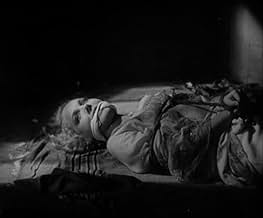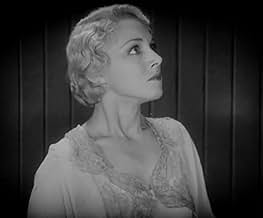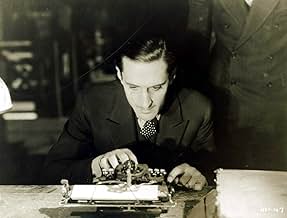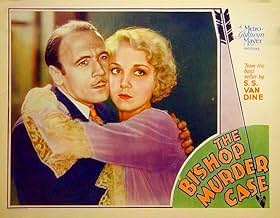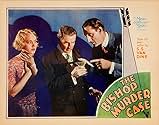Ajouter une intrigue dans votre langueWhen the body of a man nicknamed "Cock Robin" is found with an arrow in the heart on an archery range along with a chess bishop as a clue, Philo Vance investigates.When the body of a man nicknamed "Cock Robin" is found with an arrow in the heart on an archery range along with a chess bishop as a clue, Philo Vance investigates.When the body of a man nicknamed "Cock Robin" is found with an arrow in the heart on an archery range along with a chess bishop as a clue, Philo Vance investigates.
- Réalisation
- Scénario
- Casting principal
Charles Quatermaine
- John Pardee
- (as Charles Quartermaine)
Sidney Bracey
- Pyne
- (as Sydney Bracey)
Richard Cramer
- Detective in Park
- (non crédité)
Frank Fanning
- Officer Manning
- (non crédité)
Marcia Mae Jones
- Hungry Child in Park
- (non crédité)
Broderick O'Farrell
- Dr. Van Pelt
- (non crédité)
Avis à la une
Basil Rathbone is a dashing, intense-looking Philo Vance in "The Bishop Murder Case," an early talkie that shows signs of the painful transition from silents. I actually had quite a bit of trouble with the sound. I saw it on television and had difficulty understanding what was being said at times.
The film, nevertheless, is very interesting, if only to see Rathbone, with those amazing eyes of his, in his pre-Sherlock Holmes days. His acting is excellent. It was also delightful to see Roland Young. Leila Hyams plays the professor's niece, and she was quite beautiful and effective. It has a good plot as well.
Parts of this film came off like a stage play, probably because some of the actors were still adjusting to film technique. And the sound was darned strange. In one of the outdoor scenes, the actors sounded as if they were speaking through megaphones. Nevertheless, Philo Vance fans should certainly enjoy it, as will others from a historical perspective.
The film, nevertheless, is very interesting, if only to see Rathbone, with those amazing eyes of his, in his pre-Sherlock Holmes days. His acting is excellent. It was also delightful to see Roland Young. Leila Hyams plays the professor's niece, and she was quite beautiful and effective. It has a good plot as well.
Parts of this film came off like a stage play, probably because some of the actors were still adjusting to film technique. And the sound was darned strange. In one of the outdoor scenes, the actors sounded as if they were speaking through megaphones. Nevertheless, Philo Vance fans should certainly enjoy it, as will others from a historical perspective.
When you consider that sound had only come in a couple of years before THE BISHOP MURDER CASE, the fact that the film still has a soundtrack that needs restoration is no surprise. But I did manage to see a good print of the film on TCM and the gleaming B&W photography belied the fact that this was made in 1930.
But my sole purpose for watching was to see what BASIL RATHBONE looked like in an early detective role as Philo Vance. The mystery itself seemed a lot like an Agatha Christie whodunit because the murders were staged by a clever killer who just wasn't smart enough to outwit Philo Vance. The final revelation involves a glass of wine with poison in it ("the vessel with the pessel" film that Rathbone did with Danny Kaye comes to mind here). Rathbone's cleverness and manner of solving the crime is reminiscent of the way he played Sherlock Holmes so well in all those Sherlock films.
He also had a crisp delivery that was lacking in the other players. Only ROLAND YOUNG managed to sound as if silent films were a thing of the past. The others were clearly still in the silent mode of acting which makes Rathbone's performance even more remarkable.
Not a great mystery by any means and the sets, despite some fine photography, are on the primitive side--but addicts of detective stories should enjoy this one.
But my sole purpose for watching was to see what BASIL RATHBONE looked like in an early detective role as Philo Vance. The mystery itself seemed a lot like an Agatha Christie whodunit because the murders were staged by a clever killer who just wasn't smart enough to outwit Philo Vance. The final revelation involves a glass of wine with poison in it ("the vessel with the pessel" film that Rathbone did with Danny Kaye comes to mind here). Rathbone's cleverness and manner of solving the crime is reminiscent of the way he played Sherlock Holmes so well in all those Sherlock films.
He also had a crisp delivery that was lacking in the other players. Only ROLAND YOUNG managed to sound as if silent films were a thing of the past. The others were clearly still in the silent mode of acting which makes Rathbone's performance even more remarkable.
Not a great mystery by any means and the sets, despite some fine photography, are on the primitive side--but addicts of detective stories should enjoy this one.
This film is the 3rd of the Philo Vance mysteries to be filmed. The first two, Canary and Greene (filmed in 1929) were pretty hard going. They starred William Powell and he would return to star in the Benson Murder case and the best of the Vance series, The Kennel Murder Case. This one, starring Basil Rathbone is a step above the first two but it is still a static film as were many of that era......transitioning to sound was an awkward time for the movies and people talked, and talked, and talked, ad infinitum. Rathbone, a very attractive, suave actor fits the role well and he plays Vance as a little less of the high-brow, somewhat obnoxious character that was portrayed in VanDine's books. The mystery is another one of those typical Philo Vance puzzlers which never turn out as you thought they might but that is the fun of it all. It's interesting to see Roland Young in a role that is different from his usual movie persona. James Donlan, as Sgt. Heath is very irritating....nobody is that stupid and you wonder how he became a policeman, let alone a sergeant. I much prefer Eugene Palette from the William Powell/Vance films in that role. The rest of the supporting cast is adequate. You probably have to be a Vance devotee and a fan of early sound pictures to appreciate this film. Being both, I enjoyed it but would recommend The Kennel Murder Case for an introduction to Philo Vance. The series hit its stride with that film and then went downhill from there. Also, see The Canary Murder Case for historical film value as it was the last film made by the amazing Louise Brooks before she went on to cinema history in Germany. But, have fun with this movie...it is worth a look if you are a fan of the genre.
"The Bishop Murder Case" is one of the best in the Philo Vance film series. The mystery seems a bit silly at first when children's nursery rhymes are used by the perpetrator of the crimes to publicize his murders, not unlike methods used by present-day serial killers. But once the plot unfolds the nursery rhyme angle makes complete sense. The Bishop is a key figure in solving the mystery as the title indicates. So keep your eyes focused on that clue. I won't say any more except to add that this is a complex mystery.
Basil Rathbone is second only to William Powell in breathing life into S.S. Van Dine's famous private investigator. It's obvious from this performance why Rathbone was chosen at the end of the decade to play Sherlock Holmes. The other actor who shines in this movie is Roland Young. Though much of the acting hearkens back to the silent era which was coming to an end, Rathbone and Young seem modern in their approach. From playing on stage and in silent pictures, actors were used to wild exaggerations and outlandish gesticulations which were no longer needed now that movies could talk. Several of the characters in "The Bishop Murder Case" have not yet adjusted to working with sound. Not so Rathbone and Young.
Another early talky distraction for modern viewers is the absence of music for dramatic effect. Since live music was used to accentuate the silent screen action and mood, it seems strange that music was not immediately utilized for the same purposes on the talky screen. Producers were misinformed that music coming from nowhere would puzzle and confuse the audience. So it took a few years for Hollywood to rid itself of this misconception. The decision not to use music plus fairly primitive sound effects (the viewer will readily recognize the sound of thunder as the sound of huge sheets of metal being snapped)take away from the overall effects of this otherwise clever and well-written murder mystery.
Basil Rathbone is second only to William Powell in breathing life into S.S. Van Dine's famous private investigator. It's obvious from this performance why Rathbone was chosen at the end of the decade to play Sherlock Holmes. The other actor who shines in this movie is Roland Young. Though much of the acting hearkens back to the silent era which was coming to an end, Rathbone and Young seem modern in their approach. From playing on stage and in silent pictures, actors were used to wild exaggerations and outlandish gesticulations which were no longer needed now that movies could talk. Several of the characters in "The Bishop Murder Case" have not yet adjusted to working with sound. Not so Rathbone and Young.
Another early talky distraction for modern viewers is the absence of music for dramatic effect. Since live music was used to accentuate the silent screen action and mood, it seems strange that music was not immediately utilized for the same purposes on the talky screen. Producers were misinformed that music coming from nowhere would puzzle and confuse the audience. So it took a few years for Hollywood to rid itself of this misconception. The decision not to use music plus fairly primitive sound effects (the viewer will readily recognize the sound of thunder as the sound of huge sheets of metal being snapped)take away from the overall effects of this otherwise clever and well-written murder mystery.
I found all of the Philo Vance films watchable, with the zippy and witty Kennel head and shoulders above the rest. Bishop was pretty good too but suffered from a cast of actors stuck in the silent era and displaying the full range of intensely melodramatic emotions that are were so essential to the making of and enjoyment of watching a silent film. Static cameras are as nothing to tortured eyes and semaphore arm histrionics.
Mr. (Cock) Robin is found flat out murdered, apparently shot with an incredibly long arrow but Vance played by skinny and incisive Basil Rathbone knows better. He predicts a series of ghastly and inhuman murders will follow conceived by a intellect bent on playing games with his pursuers by couching his dastardly deeds in very handy nursery rhymes. He and one of the suspects, evergreen Roland Young are the only two to act naturally throughout, if still very slightly stagey. The photography is occasionally startlingly good, if still static. None of these criticisms bother me, I love it just the same as a well crafted atmospheric entertaining potboiler. Favourite bits: The scene in Dillard's library with the thunderstorm raging outside; the sedate and well-mannered way Vance and the cops enter Dillard's aerodrome of a house to search for the murderer.
I hadn't seen this since 1995, the last time UK Channel 4 gave anyone interested their opportunity to watch it. TCM UK unlike TCM US will never have room for it in their admirably varied schedule either (hem). But it's worth hunting down with all its faults for 90 minutes in the company of the world of 1929.
Mr. (Cock) Robin is found flat out murdered, apparently shot with an incredibly long arrow but Vance played by skinny and incisive Basil Rathbone knows better. He predicts a series of ghastly and inhuman murders will follow conceived by a intellect bent on playing games with his pursuers by couching his dastardly deeds in very handy nursery rhymes. He and one of the suspects, evergreen Roland Young are the only two to act naturally throughout, if still very slightly stagey. The photography is occasionally startlingly good, if still static. None of these criticisms bother me, I love it just the same as a well crafted atmospheric entertaining potboiler. Favourite bits: The scene in Dillard's library with the thunderstorm raging outside; the sedate and well-mannered way Vance and the cops enter Dillard's aerodrome of a house to search for the murderer.
I hadn't seen this since 1995, the last time UK Channel 4 gave anyone interested their opportunity to watch it. TCM UK unlike TCM US will never have room for it in their admirably varied schedule either (hem). But it's worth hunting down with all its faults for 90 minutes in the company of the world of 1929.
Le saviez-vous
- AnecdotesSeveral times Sigurd Arnesson (Roland Young) sarcastically calls Philo Vance (Basil Rathbone) "Sherlock Holmes". Nine years later, Rathbone would take the role of Holmes in Le chien des Baskerville (1939) (and 14 sequels), and it became his iconic role.
- GaffesWhen Vance and fellow detectives investigate the body of Robin, who has been shot with an arrow, the angle of the arrow changes. Sometimes it's straight up out of the body, other times it's at almost a 45 degree angle.
- Citations
Philo Vance: [to Heath] Sergeant, you're much too trusting for this deceitful world. If everything happened as easy as that, life would be very simple and very dull.
- ConnexionsFollowed by The Benson Murder Case (1930)
- Bandes originalesWaltz of the Flowers
(1891-2) (uncredited)
from "The Nutcracker Suite, Op.71a"
Written by Pyotr Ilyich Tchaikovsky
Played on piano by Basil Rathbone
Meilleurs choix
Connectez-vous pour évaluer et suivre la liste de favoris afin de recevoir des recommandations personnalisées
- How long is The Bishop Murder Case?Alimenté par Alexa
Détails
- Date de sortie
- Pays d’origine
- Langue
- Aussi connu sous le nom de
- Дело об убийстве епископа
- Lieux de tournage
- Grant's Tomb, Riverside Drive, Ville de New York, New York, États-Unis(Vance's car drives past in a second unit shot)
- Société de production
- Voir plus de crédits d'entreprise sur IMDbPro
- Durée
- 1h 28min(88 min)
- Couleur
Contribuer à cette page
Suggérer une modification ou ajouter du contenu manquant

